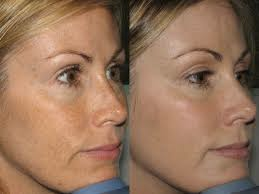A photo facial or photorejuvenation is uses some kind of light-based technology, primarily for boosting collagen, treating brown spots, diminishing broken capillaries, spider veins, facial redness and it can treat acne as well. It is a 30-minutes procedure in which intense pulses of light are used to penetrate deep into the skin. IPL photo rejuvenation then causes collagen and blood vessels below the epidermis to constrict, reducing redness and age lines. It is used to improve a variety of skin imperfections and benign conditions.
The process induces controlled wounds on the skin, prompting it to heal itself by creating new cells. This process reverses the signs of photoaging to a certain extent by removing appearances of damage.
Benefits of IPL treatment
The benefits of intense pulsed light therapy cover almost the entire spectrum of cosmetic dermatology. When performed by a qualified skin care specialist, IPL™ photofacial treatment can help nearly all aspects of skin aesthetics and structure.
- The treatment can help repair small blood vessels that have become visible, or help eradicate sun spots or other pigmentation irregularities.
- IPL treatment can help combat acne problems and eliminate large pores.
- IPL photofacial therapy is also excellent at treating rosacea and other types of diffuse redness in the skin.
- By treating a slightly deeper layer of the skin, IPL photofacials stimulate collagen growth by simulating minor dermal injuries, thereby helping to improve skin texture.
Another benefit of IPL photorejuvenation procedures is that they allow for additional treatment with chemical peels, microdermabrasion, and other facial skin treatments that target the outermost layer of skin, the epidermis. Since IPL photofacials target deeper layers of the skin, they can be safely performed in conjunction with other, more superficial treatments.
Frequently Asked Questions
The number of IPL photo facials you need will vary depending on the condition you’re treating, the results you want, and how your skin responds.
There’s no downtime after a photofacial. A temporary flushing that dissipates within hours may occur, but you can go right back to work, school or shopping after a treatment. Photo facials are gentle and don’t cause pain.
One of the reasons IPL photofacial procedures have become so popular is that their benefits heavily outweigh their risks. The potential side effects of photofacial such as swelling, redness, increased visibility of small capillaries and facial flushing, are minor and usually disappear within a few hours or days of the procedure.
If you are honest and thorough with your physician about your medical history, you will most likely not encounter any severe complications from IPL™ photofacial treatment. Some factors that would prevent you from safely receiving treatment include pregnancy, open lesions, skin cancer, and keloid formation (excessive raised scarring). Be sure to discuss your medical history and any medications you are currently taking with your skin care specialist before undergoing treatment.
After one facial, clients should expect to see and feel smoother skin. Age spots initially become darker and then move to the skin’s surface where they fall away as part of the skin’s natural exfoliation process. Skin and pores feel and look tighter, while fine lines and wrinkles slowly decrease in size. For maximum benefit, five treatments spanning a year are recommended for most skin types.
Some clinics or medi-spas have LED (light-emitting diode) equipment. It is usually called light therapy, and LED facial, or LED treatment, but it is sometimes called a photo facial. However, IPL and LED are completely different, so it’s extremely important to understand which photo facial technology is being used. That way you are more likely to get the results you hope to achieve.
An LED photo facial is a very gentle treatment that uses narrow spectrum light to boost collagen, which creates plumper, younger-looking skin, or to kill the bacteria that causes acne.
LED photo facials are painless, cool and relaxing, and carry no risk of burning. The best results come after a series of photo facial treatments. To begin, a series of six treatments with a one-to two weeks between is recommended. After that, maintain with a treatment every month or two. It can be part of a facial or a stand-alone treatment.
LED photo facials are a good choice for people who want to boost collagen or treat acne. Their collagen-boosting, facial rejuvenation properties have been proven with medical research. The results won’t be as dramatic as plastic surgery, but it’s a gentler, more natural, less expensive way to go.



